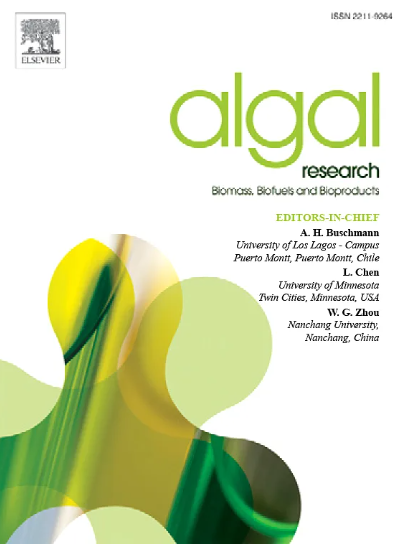Combination of Sargassum wightii extract and pyridoxin mixture improves growth and salinity tolerance in Okra for sustainable agriculture
IF 4.5
2区 生物学
Q1 BIOTECHNOLOGY & APPLIED MICROBIOLOGY
Algal Research-Biomass Biofuels and Bioproducts
Pub Date : 2025-06-14
DOI:10.1016/j.algal.2025.104145
引用次数: 0
Abstract
Salinity is a major problem for food security and sustainable development in the world. Applying effective seaweeds and pyridoxine mixture offer a potential in the form of bio-stimulants for improving plant growth and ecophysiological output. This study was designed to compare impact of Sargassum wightii extract (2 and 4 %) and pyridoxine 0.04 % and their mixture for the first time on Abelmoschus esculentus plants under 125 mM NaCl to enhance its salt tolerance and biomass production. Plant growing with the S. wightii extract (2 and 4 %) and pyridoxine 0.04 % mixture stimulated the growth parameters around (28 to 107 %) compared to their sole effects. Spraying of S. wightii aqueous extract (2 and 4 %) and pyridoxine (0.04 %) alone and in combination improved the relative water contents (57 % in control, 16–78 % in salinity) and essential minerals uptake (26–40 %) while reduced (40 %) sodium levels for optimum ion homeostasis especially in salinity. Plants treated with S. wightii extract and pyridoxin mixture enhanced antioxidant enzyme activities but hydrogen peroxide, catalase and abscisic acid, were reduced. Application of S. wightii (4 %) with pyridoxine (0.04 %) worked as natural bio-stimulants for amelioration of salt stress and biomass production of okra.

马尾藻提取物与吡哆毒素混合可提高秋葵的生长和耐盐性,有利于可持续农业
盐碱化是影响世界粮食安全和可持续发展的重大问题。施用有效的海藻和吡哆醇混合物提供了一种潜在的生物刺激剂的形式,以改善植物的生长和生态生理输出。在125 mM NaCl条件下,首次比较了马尾藻提取物(2%、4%)和pyridoxine(0.04%)及其混合物对沙豆(Abelmoschus esculentus)植株耐盐性和生物量的影响。与单独作用相比,皂角提取物(2%和4%)和吡啶醇(0.04%)对植物生长的影响约为28 ~ 107%。喷施白花参水提物(2%和4%)和吡啶醇(0.04%)单独或联合喷施提高了相对含水量(对照57%,盐度16 - 78%)和必需矿物质吸收率(26 - 40%),同时降低了钠水平(40%),以达到最佳离子稳态,特别是在盐度条件下。白桦提取物与吡哆醇混合处理的植株抗氧化酶活性增强,过氧化氢酶、过氧化氢酶和脱落酸活性降低。在黄秋葵(4%)和pyridoxine(0.04%)的配合下,黄秋葵可作为天然生物刺激剂改善盐胁迫,提高生物量。
本文章由计算机程序翻译,如有差异,请以英文原文为准。
求助全文
约1分钟内获得全文
求助全文
来源期刊

Algal Research-Biomass Biofuels and Bioproducts
BIOTECHNOLOGY & APPLIED MICROBIOLOGY-
CiteScore
9.40
自引率
7.80%
发文量
332
期刊介绍:
Algal Research is an international phycology journal covering all areas of emerging technologies in algae biology, biomass production, cultivation, harvesting, extraction, bioproducts, biorefinery, engineering, and econometrics. Algae is defined to include cyanobacteria, microalgae, and protists and symbionts of interest in biotechnology. The journal publishes original research and reviews for the following scope: algal biology, including but not exclusive to: phylogeny, biodiversity, molecular traits, metabolic regulation, and genetic engineering, algal cultivation, e.g. phototrophic systems, heterotrophic systems, and mixotrophic systems, algal harvesting and extraction systems, biotechnology to convert algal biomass and components into biofuels and bioproducts, e.g., nutraceuticals, pharmaceuticals, animal feed, plastics, etc. algal products and their economic assessment
 求助内容:
求助内容: 应助结果提醒方式:
应助结果提醒方式:


